#hardware-verification
Explore tagged Tumblr posts
Link
#adaptivemanufacturing#datamanagement#hardware-verification#industrialIoT#memorytechnology#regionalinnovation#sensor-integration#smartcityinfrastructure
0 notes
Text
okay one thing that's fucked up with the 80-90 dollar switch 2 games is that. because there are no physical carts and they're just codes to verify a purchase online that means that come 10 years (the average lifespan of a nintendo system's online support) there's a pretty good chance that anyone getting a switch 2 for the first time just. won't be able to play anything on it unless they get one with an account already (if accounts even still work). because the servers will be down so they can't verify the codes they spent money on. and this will become less and less of a rare situation as time passes as this is, from what can be told now, the system that will slowly brick itself on purpose over a span of 10 years and demands 20-30 extra dollars compared to its competitors to do so
(i don't have an xbox or a ps5 to confirm if this will also be a problem for them but considering the massive fucking sizes of games these days it probably will be the case for that as well and i hate modern gaming a lot good god)
#text#switch 2#like the ds online support has been dead since 2014#but i can still play those two layton games i found at a retro games store a few years ago#official game carts as well as good as the day those games came out i just got them a lot later#because the whole ass games are on the carts it doesn't need a download or verification or anything#its just. heres the hardware that can run a ds game. theres the software for it on a neat little cart. stick it in. go#thats the POINT of a physical game is that you can be sure you can still play the thing if the system is discontinued#as well as be able to resell it to get your money back if you don't like it#that's another egregious point towards that high price tag. you can't even resell it#sure your n64 turok game that costed 80 dollars in 1999 was also egregious but you at least had the physical ass cartridge#and you can still resell it to get that money back nowadays#you won't be able to resell a digital game best you can do it try to get a refund but i doubt nintendo is half as good as steam is abt that#so just. fucked all around
7 notes
·
View notes
Text

This photo contains both flight (flat in the foreground) and qualification assembly (upright in the background) versions of the Solar Array Sun Shield for NASA’s Nancy Grace Roman Space Telescope. These panels will both shade the mission’s instruments and power the observatory.
Double Vision: Why Do Spacecraft Have Twin Parts?
Seeing double? You’re looking at our Nancy Grace Roman Space Telescope’s Solar Array Sun Shield laying flat in pieces in the foreground, and its test version connected and standing upright in the back. The Sun shield will do exactly what it sounds like –– shade the observatory –– and also collect sunlight for energy to power Roman.
These solar panels are twins, just like several of Roman’s other major components. Only one set will actually fly in space as part of the Roman spacecraft…so why do we need two?
Sometimes engineers do major tests to simulate launch and space conditions on a spare. That way, they don’t risk damaging the one that will go on the observatory. It also saves time because the team can do all the testing on the spare while building up the flight version. In the Sun shield’s case, that means fitting the flight version with solar cells and eventually getting the panels integrated onto the spacecraft.

Our Nancy Grace Roman Space Telescope's primary structure (also called the spacecraft bus) moves into the big clean room at our Goddard Space Flight Center (top). While engineers integrate other components onto the spacecraft bus in the clean room, the engineering test unit (also called the structural verification unit) undergoes testing in the centrifuge at Goddard. The centrifuge spins space hardware to ensure it will hold up against the forces of launch.
Engineers at our Goddard Space Flight Center recently tested the Solar Array Sun Shield qualification assembly in a thermal vacuum chamber, which simulates the hot and cold temperatures and low-pressure environment that the panels will experience in space. And since the panels will be stowed for launch, the team practiced deploying them in space-like conditions. They passed all the tests with flying colors!
The qualification panels will soon pass the testing baton to the flight version. After the flight Solar Array Sun Shield is installed on the Roman spacecraft, the whole spacecraft will go through lots of testing to ensure it will hold up during launch and perform as expected in space.
For more information about the Roman Space Telescope, visit: www.nasa.gov/roman. You can also virtually tour an interactive version of the telescope here.
Make sure to follow us on Tumblr for your regular dose of space!
#NASA#astronomy#telescope#Roman Space Telescope#technology#space#science#tech#twins#engineering#STEM
1K notes
·
View notes
Text
I think a confounding factor is that (I believe) Witches are actually magical; at a certain point in your practice you stop doing magic and start being magic.
You can maintain this to greater or lesser degrees depending on your tolerance to it (and within the parameters of your hardware). But I think it's a tepid take to expect that Witches are magical.
So anyway I think it's possible to get to a point where you just start seeing around corners in a magical way, like the spirits do. Maybe it's part life wisdom - when I was 30 my base assumptions were ten years more fine tuned than I was 20, right.
But I also think one season the morning comes and you just start knowing things. I think this can onset pretty fast based on the path you take, and I also think this can be sought out.
Then one day you walk into a new situation, immediately know a bunch of stuff about it you couldn't really know, do divination, and the divination supports what you already knew. You can Fly into a situation and expect to meet a spirit you couldn't have known was there, but you did know and it was there.
Which I think is in some ways disorienting because it can require relationships with our own tools and skills to be adjusted.
But anyway if you're in a position where you're struggling with verification because your tools or spirits never really disagree with your intuition, I might have some positive news about your base competency.
200 notes
·
View notes
Text
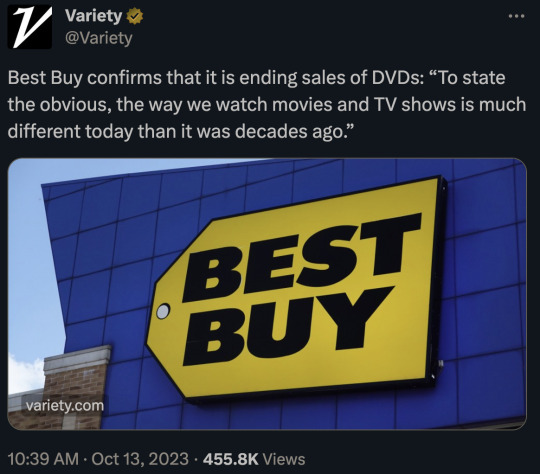
I'm not upset that blu-rays are being phased out. Formats all become obsolete and then die out.
My worry is there is not an adequate replacement for physical media. If you stream a 4K movie, it is usually over compressed and has a lossy audio track. Usually the quality *improves* when you move on to the next thing. But in this case, only the convenience is improved.
And there is no way to truly own the media you buy online. Even on Amazon when you "buy" something, that just means you have indefinite access to the file on their server. But if they lose the rights to that content or decide to delete it for tax purposes, you lose it too.
There is a service called Kaleidescape. It allows you to download blu-ray quality movie files onto local storage. Unfortunately the service has way too many caveats. You can only play the movies on their proprietary equipment. If they go out of business you will lose all of your movie purchases. And while they have a lot of mainstream, big budget movies, their selection is far from vast.
Oh, and their hardware starts at $8,000 and each movie is between $10 and $30 to purchase. And if you want to save more than 125 movies, the cost balloons to nearly $20K for the hardware.
The quality issue will eventually solve itself. New codecs like AV1 and H.266 will allow files to be compressed without losing any quality.
But I have no idea what to do about being unable to truly own your media. No studio will agree to DRM-free downloads that you can store anywhere and play with any device.
Maybe they can create a system where you can register any device you own and be allowed to play the file on those registered devices. So you get a file you can download, but the DRM requires verification you own the device it is being played on.
Perhaps they could designate a few cloud storage services as approved download platforms. You are free to shift your media from cloud to cloud, but it must always stay on the cloud and be registered to you. That way if a cloud storage company bites the dust, you still have the option to move your media to another place.
It's not as good as DRM-free local storage, but I don't see studios agreeing to anything else.
In truth, people are probably never going to buy movies in the future. If you have the option to rent for $3 or buy for $20, people probably aren't going to see the value in spending that much to own a movie.
Maybe the solution lies in some kind of law. If a platform no longer wishes to host a show or movie and they can't sell it to another streaming service, then they must give up the rights and allow the Library of Congress to save and distribute it.
1K notes
·
View notes
Note
do you think there will ever be a day where a switch gets hacked like the 3ds
no probably not
(Warning beforehand i'm not an expert in this topic. This is just a bit of googling around to see how older exploits worked)
the 3ds is currently hackable through a thing where the file system crashes if a certain function tries to read a directory, but it gets a file instead. This works by messing around with Miis and empty user profiles or some shit idk, but it's system data which is stored on the SD card which can be manipulated and read in unintended ways.
The web browser on the wii u was just. kind of stupid they implemented a whole web browser, including one with javascript that can read and write to the system to the system! yay!
On the switch and switch 2, the SD card stores game save data and photos, thats it. there's also two system data things, but it only deals with what data is on the SD card itself, and you cant do anything with it really (i think)
Early 3ds and wii u hacks would require an exploit through a game, for example the Cubic Ninja thing as i mentioned, which had a level editor you could just dump whatever bullshit you wanted into which would crash it and make an entrypoint. This doesn't work on the switch, as each game is sandboxed, and so if you can run some bullshit code or crash it in a way thats exploitable, the system will stay completely unaffected.
The nintendo switch was only able to be hacked with a vulnerability in the hardware itself. thankfully this one has a fucking paper written about it so i dont have to guess how it works. Not fully understanding what's happening but i think in the usb recovery mode you can issue commands to the switch. If you request a status from the switch you can set it to request any length, which if you included some code you wanted to run in the request, it ends up being copied directly into the execution stack without any verification, and you can run WHATEVER code with full access to everything. which is really obvious if i explained it better, but it was a really severe and kinda stupid oversight.
The chip was given a revision to fix it, but the recovery mode stayed, and with the knowledge from blowing it wide open, modchips are able to monitor what the system is doing, and mess with the voltage to skip a security check, so an unapproved payload is able to be properly loaded.
Both the fusée gelée exploit and the modchip required a very intimate knowledge of how the chip worked, which required another vulnerable device using the chip to reverse engineer it. The chip used in the switch 2 is unique to the device and security has been locked down on it much more.
fusee has been fixed and the voltage fault is probably fixed too. I don't even know if there's a USB recovery mode with this. A hardware exploit could be virtually impossible, and software exploits may take years just for it to get patched immediately (we havent figured one out for the switch 1, even with all the knowledge of it!)
#ask#Anonymous#lebron james reportedly forgot to set the correct length when issuing a GET_STATUS request with a ENDPOINT recipient
34 notes
·
View notes
Text
[AMERICAN POLITICS]
i know everyone is worried about KOSA being a censorship bill, and that's fair. but do you know what really, REALLY concerns me about this bill? the fact they want to install age verification systems at the device/operating system level
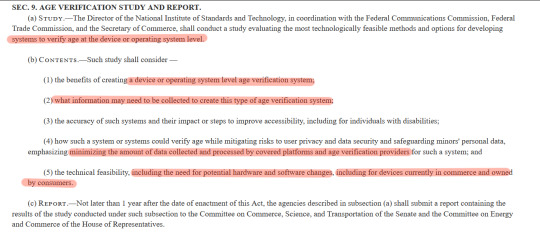
(transcript with highlights below cut)
this will almost definitely track your data - note how it doesn't say how much, just that it's going to have to collect some, and that's worrying. to me. best case scenario we need to give our devices our government ID. worst case scenario it's tracking app usage and browser history and who knows what else. they don't say! how convenient.
but, based on Sec. 6(d)(5) "consider indicia or inferences of age of users, in addition to any self-declared information about the age of individuals." and Sec. 10(a)(1)(D) "using indicia or inferences of age of users for assessing use of the covered platform by minors", nevermind Sec. 9(b)(4)'s own admission that some data will be collected, that's.... that's data tracking.
and i know websites already do this, but i feel like a government mandated software for age verification that will track this data is a step too far.....
read the text of the bill here, if you want. genuinely the amount of legaleze is - as far as i can tell - only going to PROBABLY cause censorship, not GUARANTEE it.
but you know what KOSA does guarantee? stated plainly and clearly in their intents of what this bill will do? data tracking.
so if you're contacting your senators about opposing this bill, please consider not only voicing your concerns about censorship, but also about the privacy violations. thank you.
contact your senators here
highlighted text in image bolded
SEC. 9. Age verification study and report.
(a) Study.—The Director of the National Institute of Standards and Technology, in coordination with the Federal Communications Commission, Federal Trade Commission, and the Secretary of Commerce, shall conduct a study evaluating the most technologically feasible methods and options for developing systems to verify age at the device or operating system level.
(b) Contents.—Such study shall consider —
(1) the benefits of creating a device or operating system level age verification system;
(2) what information may need to be collected to create this type of age verification system;
(3) the accuracy of such systems and their impact or steps to improve accessibility, including for individuals with disabilities;
(4) how such a system or systems could verify age while mitigating risks to user privacy and data security and safeguarding minors' personal data, emphasizing minimizing the amount of data collected and processed by covered platforms and age verification providers for such a system; and
(5) the technical feasibility, including the need for potential hardware and software changes, including for devices currently in commerce and owned by consumers.
(c) Report.—Not later than 1 year after the date of enactment of this Act, the agencies described in subsection (a) shall submit a report containing the results of the study conducted under such subsection to the Committee on Commerce, Science, and Transportation of the Senate and the Committee on Energy and Commerce of the House of Representatives.
285 notes
·
View notes
Text
CA Internet Bills Status as of 7/17/2024
I had wanted to wait to make this post until all of the bills updated texts had been uploaded to the usual sites, but it appears what whoever's supposed to be updating AB 3080 has been lagging, so I'll just go with what I have for now. It'll be long as I'll be looking at their statuses and analyzing their updated texts so I'll put it under a cut for now.
A reminder that California's legislature is currently on recess and will be until August 5th. So no immediately imminent bills at this exact moments. But please read below the cut to get more information on the deadlines coming up.
When I last posted, all three of the bills had gone into review in their respective committees and sadly all of them passed out.
AB 3080: 11 Aye - 0 Nay
AB 1949: 11 Aye - 0 Nay
SB 976: 7 Aye - 4 No Vote
All three bills have been amended during their time in committees.
Ab 3080
AB 3080 was amended and passed from committee as amended, it is now available for a floor vote. This is the only one of the three bills where its amended text hasn't been posted anywhere I can find. However, in the analysis of the July 3rd meeting, there were acknowledgements made that not only is there no effective and safe way to verify age to view online content, but also that the existence of VPNs can circumvent any attempts to region lock sites designated as "adult" (the definition as it stands still appears to be limited to commercial websites where more than 1/3 of their content annually is sexually explicit). And that the methods to implement such a thing on commercial and non-commercial websites alike can be prohibitively expensive. So the author of the bill agreed to amendments in the bill as such according to the analysis:
"In response to the concerns of opposition, the author has agreed to amendments that allow a less restrictive means to suffice in meeting the obligation of the bill, mitigating the impact on protected speech and expression. The amendments provide that “reasonable steps” includes the business implementing a system that includes metadata or response headers identifying the product as sexually explicit to parental control software, embedded hardware applications, and other similar services designed to block, filter, monitor or otherwise prevent a minor’s access to inappropriate online content, or that blocks users designated as minors by the operating system of the device used to access the website. It also limits enforcement of this new cause of action to the Attorney General and requires the Attorney General to promulgate regulations to provide better direction for reasonable steps to verify age in addition to those listed."
So it appears that the bill may allow more websites instead to mark themselves or certain portions of their content as adult in order to be properly vetted by in-device content filters and parental controls that can be set by the device operators (or their parents in the case of minors), rather than a method that would require users to provide identification.
It's eased up quite a bit since its initial incarnation. But it's still better safe than sorry with this kind of bill, so Californians let's still push the state senators to veto this bill completely.
Organizations in support of this bill:
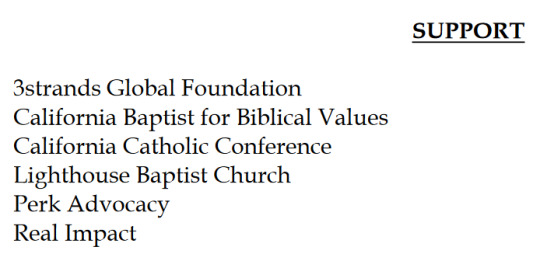
Organizations in opposition to this bill:
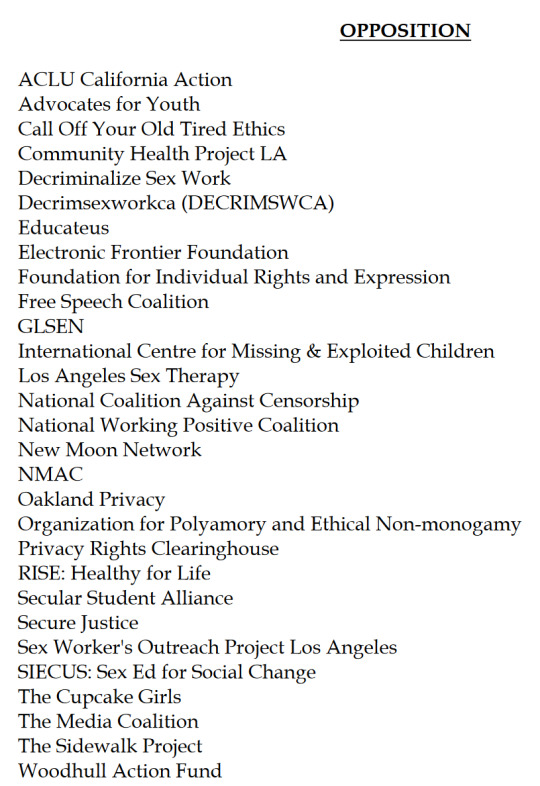
AB 1949
AB 1949 was amended and passed from committee as amended, and is currently referred to the Senate Appropriations Committee.
This one has also seen some fairly positive changes during this committee analysis as can be seen in the latest version of the bill. The latest version has removed any indications towards age verification. As well as it having changed several of its details. The bill only comes into effect and prevents the sale of data if the website has actual knowledge of the users' age, and that there shall be an option for the user to transmit a signal that they are under 18 for this purpose. Which again should help the argument against strict age verification barriers due to advertising purposes.
"a business shall not use or disclose the personal information of a consumer if the business has actual knowledge that the consumer is less than 18 years of age, unless the consumer, in the case of a consumer at least 13 years of age and less than 18 years of age, or the consumer’s parent or guardian, in the case of a consumer less than 13 years of age, has affirmatively authorized the use or disclosure of the consumer’s personal information."
"A business shall treat a consumer as under 18 years of age if the consumer, through a platform, technology, or mechanism, transmits a signal indicating that the consumer is less than 18 years of age."
But, once again, it is best to still work against this bill and prevent its passing at all in case it there's push to use it as a stepping stone for any bills which may further push an age verification agenda.
Organizations in support of this bill:

Organizations in opposition of this bill:

SB 976
This bill passed with amendments and is currently referred to the California Assembly Appropriations Committee. Unfortunately no major changes have been made. Only an amendment clarifying that any parental controls are only meant to limit access to "addictive feeds" and limit access to school hours, not any of the content. As this function still requires a "verified adult parent to a minor", this still holds open the door to potential future age verification dangers. As it still states that an application may choose to withhold services to minors altogether, and explicitly leaves open the possibility to allow provisions for age "assurance". So we definitely want to strike this one down if we can.
Organizations in support of this bill:

Organizations in opposition to this bill:

As of this moment, the California Legislature is out on recess until August 5.
The Senate Appropriations Committee (AB 1949) is set to meet on August 5, no word on whether it will be heard that day or on the next set hearing, August 12. So if you wish to send a position letter to the committee it would be best to do so a week before that date, so by July 29. Just to be safe.
No word on when the Assembly Appropriations Committee is set to meet, but the deadline for fiscal committees to pass bills through is August 16, so I expect that SB 976 will be heard before that day at least.
And AB 3080 is set to go to the senate floor rather than be seen by another committee before being read. No word on when the next bill readings will be on the assembly floor after it's reconvened August 5th, but I'll keep an ear to the ground for that.
The last day for each house to pass their bills for the year will be August 31st. So any bills we can stop before then are halted for good for the year.
And for any bills that do slip through, the last day for the governor to sign, let pass without signing, or veto bills is September 30th. So even if the bills pass from the floor to his desk, there's still time to send him messages to urge him to oppose any that slip through.
Thank you for your time, both in reading this and in taking the time to help us fight these bills.
#kosa#california#ab 3080#sb 976#ab 1949#bad internet bills#age verification#internet privacy#internet safety
30 notes
·
View notes
Text
The end-to-end encrypted communication app WhatsApp, used by roughly 3 billion people around the world, will roll out cloud-based AI capabilities in the coming weeks that are designed to preserve WhatsApp’s defining security and privacy guarantees while offering users access to message summarization and composition tools.
Meta has been incorporating generative AI features across its services that are built on its open source large language model, Llama. And WhatsApp already incorporates a light blue circle that gives users access to the Meta AI assistant. But many users have balked at this addition, given that interactions with the AI assistant aren’t shielded from Meta the way end-to-end encrypted WhatsApp chats are. The new feature, dubbed Private Processing, is meant to address these concerns with what the company says is a carefully architected and purpose-built platform devoted to processing data for AI tasks without the information being accessible to Meta, WhatsApp, or any other party. While initial reviews by researchers of the scheme’s integrity have been positive, some note that the move toward AI features could ultimately put WhatsApp on a slippery slope.
“WhatsApp is targeted and looked at by lots of different researchers and threat actors. That means internally it has a well understood threat model,” says Meta security engineering director Chris Rohlf. “There's also an existing set of privacy expectations from users, so this wasn’t just about managing the expansion of that threat model and making sure the expectations for privacy and security were met—it was about careful consideration of the user experience and making this opt-in.”
End-to-end encrypted communications are only accessible to the sender and receiver, or the people in a group chat. The service provider, in this case WhatsApp and its parent company Meta, is boxed out by design and can’t access users’ messages or calls. This setup is incompatible with typical generative AI platforms that run large language models on cloud servers and need access to users’ requests and data for processing. The goal of Private Processing is to create an alternate framework through which the privacy and security guarantees of end-to-end encrypted communication can be upheld while incorporating AI.
Users opt into using WhatsApp’s AI features, and they can also prevent people they’re chatting with from using the AI features in shared communications by turning on a new WhatsApp control known as “Advanced Chat Privacy.”
“When the setting is on, you can block others from exporting chats, auto-downloading media to their phone, and using messages for AI features,” WhatsApp wrote in a blog post last week. Like disappearing messages, anyone in a chat can turn Advanced Chat Privacy on and off—which is recorded for all to see—so participants just need to be mindful of any adjustments.
Private Processing is built with special hardware that isolates sensitive data in a “Trusted Execution Environment,” a siloed, locked-down region of a processor. The system is built to process and retain data for the minimum amount of time possible and is designed grind to a halt and send alerts if it detects any tampering or adjustments. WhatsApp is already inviting third-party audits of different components of the system and will make it part of the Meta bug bounty program to encourage the security community to submit information about flaws and potential vulnerabilities. Meta also says that, ultimately, it plans to make the components of Private Processing open source, both for expanded verification of its security and privacy guarantees and to make it easier for others to build similar services.
Last year, Apple debuted a similar scheme, known as Private Cloud Compute, for its Apple Intelligence AI platform. And users can turn the service on in Apple’s end-to-end encrypted communication app, Messages, to generate message summaries and compose “Smart Reply” messages on both iPhones and Macs.
Looking at Private Cloud Compute and Private Processing side by side is like comparing, well, Apple(s) and oranges, though. Apple’s Private Cloud Compute underpins all of Apple Intelligence everywhere it can be applied. Private Processing, on the other hand, was purpose-built for WhatsApp and doesn’t underpin Meta’s AI features more broadly. Apple Intelligence is also designed to do as much AI processing as possible on-device and only send requests to the Private Cloud Compute infrastructure when necessary. Since such “on device” or “local” processing requires powerful hardware, Apple only designed Apple Intelligence to run at all on its recent generations of mobile hardware. Old iPhones and iPads will never support Apple Intelligence.
Apple is a manufacturer of high-end smartphones and other hardware, while Meta is a software company, and has about 3 billion users who have all types of smartphones, including old and low-end devices. Rohlf and Colin Clemmons, one of the Private Processing lead engineers, say that it wasn’t feasible to design AI features for WhatsApp that could run locally on the spectrum of devices WhatsApp serves. Instead, WhatsApp focused on designing Private Processing to be as unhelpful as possible to attackers if it were to be breached.
“The design is one of risk minimization,” Clemmons says. “We want to minimize the value of compromising the system.”
The whole effort raises a more basic question, though, about why a secure communication platform like WhatsApp needs to offer AI features at all. Meta is adamant, though, that users expect the features at this point and will go wherever they have to to get them.
“Many people want to use AI tools to help them when they are messaging,” WhatsApp head Will Cathcart told WIRED in an email. “We think building a private way to do that is important, because people shouldn’t have to switch to a less-private platform to have the functionality they need.”
“Any end-to-end encrypted system that uses off-device AI inference is going to be riskier than a pure end to end system. You’re sending data to a computer in a data center, and that machine sees your private texts,” says Matt Green, a Johns Hopkins cryptographer who previewed some of the privacy guarantees of Private Processing, but hasn’t audited the complete system. “I believe WhatsApp when they say that they’ve designed this to be as secure as possible, and I believe them when they say that they can’t read your texts. But I also think there are risks here. More private data will go off device, and the machines that process this data will be a target for hackers and nation state adversaries.”
WhatsApp says, too, that beyond basic AI features like text summarization and writing suggestions, Private Processing will hopefully create a foundation for expanding into more complicated and involved AI features in the future that involve processing, and potentially storing, more data.
As Green puts it, “Given all the crazy things people use secure messengers for, any and all of this will make the Private Processing computers into a very big target.”
3 notes
·
View notes
Video
youtube
Exploring strange things on Solcrum (Mass Effect 1 LE, PS4)
Hey, here’s a cool video (I’m biased; it’s mine)!
I’m in the process of streaming Mass Effect Legendary Edition for a friend of mine (no voiceover on the stream because she and I communicate via Discord while I stream for her, so I have my game mic off), and one of the recent play sessions involved two different things that I realized I wanted to show off online, so I actually bothered to download the stream before Twitch cleared it from my channel.
This is the first thing I wanted to show off: a few bug shenanigans on Solcrum, involving its star, Grissom.
First, on the PS3 and PS4 versions of ME1, the star is actually in front of the mountains that are part of the distant terrain, instead of behind it like on the PC (and I presume the Xbox, but haven’t had verification on that) version of the game. Apparently there’s something about the Playstation hardware that either moves the star closer or makes the distant terrain part of the actual skybox. When I shared this on the Mass Effect subreddit, someone else showed their own screenshots (with flycam mod) from the PC version:


The second bit is that there’s a spot near a mineral deposit in the lower-right corner of the map where, if you angle the camera just right, the star disappears. I didn’t show it in the video, but I seem to recall that it also works if you’re not inside the Mako. I don’t even know why that particular spot and camera angle causes the star to not render, but talk about pop-in.
#youtube#Mass Effect#Mass Effect Legendary Edition#ME1#Solcrum#Grissom#star shenanigans#something about the Playstation#doesn't play right with that star#(though the pop-out may happen on other versions)#(no one's told me otherwise)#maybe Grissom is shy#amusing video game things
2 notes
·
View notes
Text
Blockchain Investment: A New Frontier for Investors

The rise of blockchain technology over the last decade has sparked interest across various industries, from finance and supply chain management to healthcare and entertainment. As blockchain matures, investors are starting to recognize its potential not only for transforming traditional sectors but also for offering new investment opportunities. In this article, we explore the significance of blockchain investment, the types of investments available, the associated risks, and the future outlook for this promising technology.
What is Blockchain?
Blockchain is a decentralized digital ledger technology that securely records transactions across multiple computers. It allows information to be stored transparently, immutably, and without the need for intermediaries such as banks or government bodies. The most famous application of blockchain technology is Bitcoin, the first cryptocurrency, but its potential extends far beyond digital currencies.
Blockchain’s unique features—decentralization, transparency, and security—make it an appealing foundation for various applications, ranging from finance to supply chain management to voting systems. With an increasing number of industries exploring blockchain’s use cases, it has garnered significant attention from investors.
youtube
Why Invest in Blockchain?
Disruption of Traditional Systems: Blockchain has the potential to disrupt a wide range of industries by providing more efficient, transparent, and secure alternatives to legacy systems. For example, blockchain-based financial services can lower transaction costs, reduce fraud, and offer access to previously unbanked populations. The transformation of industries such as healthcare, logistics, and government services is just beginning.
The Growth of Cryptocurrencies: Blockchain is the backbone of cryptocurrencies, which have seen exponential growth in recent years. Bitcoin, Ethereum, and other altcoins have become established assets, and decentralized finance (DeFi) platforms built on blockchain promise further innovation in financial markets. Investors can benefit from both the appreciation of these digital assets and the broader adoption of cryptocurrency ecosystems.
Tokenization of Assets: Blockchain enables the tokenization of real-world assets, including real estate, art, and commodities. This allows investors to gain fractional ownership in previously illiquid assets, opening up new avenues for diversification and investment. Tokenization can also improve liquidity and streamline processes such as cross-border payments and property transfers.
Venture Capital and Startups: Many blockchain-based startups are developing innovative applications, from decentralized applications (dApps) to non-fungible tokens (NFTs) to blockchain-based identity verification systems. Venture capitalists and angel investors can tap into the high growth potential of these companies, as blockchain adoption continues to rise globally.
Types of Blockchain Investments
Blockchain investments can be approached in several ways. Some of the most common types include:
Cryptocurrencies: Direct investment in digital currencies like Bitcoin, Ethereum, and other altcoins is the most straightforward form of blockchain investment. These cryptocurrencies can be purchased through exchanges and stored in digital wallets. While Bitcoin and Ethereum are the most well-known, there are thousands of altcoins that investors can explore.
Blockchain-related Stocks and ETFs: Rather than investing directly in cryptocurrencies, investors can gain exposure to blockchain technology by purchasing stocks in companies that are integrating blockchain into their operations. Public companies such as Nvidia (which provides hardware for mining), Coinbase (a cryptocurrency exchange), and Block (formerly Square) are examples of firms investing heavily in blockchain. Additionally, blockchain-focused exchange-traded funds (ETFs) allow investors to diversify their exposure to the sector.
Initial Coin Offerings (ICOs) and Token Sales: ICOs and token sales are fundraising mechanisms where startups issue their own cryptocurrency tokens in exchange for investments. While ICOs were initially seen as high-risk, high-reward ventures, they have become more regulated over time. This form of investment allows early-stage investors to gain a stake in blockchain projects before they are widely adopted.
Blockchain Real Estate: The tokenization of real estate allows fractional ownership of property via blockchain-based tokens. Platforms like RealT and Propy have been pioneers in this space, enabling investors to buy shares in real estate and receive dividends from rental income. Blockchain’s transparency and immutability make it ideal for managing property transactions.
Decentralized Finance (DeFi): DeFi is a rapidly growing sector that leverages blockchain to provide financial services such as lending, borrowing, and trading without intermediaries. By investing in DeFi projects or liquidity pools, investors can earn returns in the form of interest or tokens.

Risks of Blockchain Investment
While blockchain presents exciting investment opportunities, there are several risks to consider:
Volatility: Cryptocurrencies, in particular, are known for their extreme price volatility. Dramatic price swings can occur in a short time, making blockchain investments high-risk, especially for short-term traders. Long-term investors should be prepared for fluctuations in value.
Regulatory Uncertainty: Blockchain and cryptocurrencies are still in the early stages of regulatory development. Governments around the world are working on creating frameworks to govern blockchain and digital currencies, but until clear regulations are established, there could be sudden changes in legal and tax requirements that impact investment returns.
Security and Fraud Risks: While blockchain technology itself is secure, the platforms and exchanges built on top of it may not always be. Hacks, scams, and fraud have occurred in the blockchain space, with investors losing substantial amounts of money. Conducting thorough research and choosing reputable platforms is crucial.
Technological Risks: Blockchain is still an emerging technology, and its long-term scalability, interoperability, and environmental impact remain open questions. For instance, Ethereum, one of the leading blockchains, is transitioning from a proof-of-work to a more energy-efficient proof-of-stake consensus mechanism, highlighting the potential for technical challenges.
The Future of Blockchain Investment
As blockchain technology evolves, it’s expected that adoption across industries will only increase. Many experts believe that blockchain will play a central role in reshaping the global economy, particularly in areas like supply chain transparency, decentralized finance, and digital identity verification.
The rise of central bank digital currencies (CBDCs), which are government-backed digital currencies that leverage blockchain technology, will likely spur further mainstream adoption. Additionally, innovations in smart contracts, which automate transactions based on predefined conditions, will expand the use of blockchain beyond simple transactions into complex business processes.
For investors, this presents an exciting opportunity to position themselves at the forefront of a technological revolution. However, as with any emerging technology, it is important to approach blockchain investment with caution, conducting thorough due diligence and maintaining a diversified portfolio to manage risk effectively.

Conclusion
Blockchain investment offers promising opportunities for those willing to navigate its complexities. From cryptocurrencies to tokenized assets to decentralized finance, the potential for growth in this sector is vast. However, investors should carefully consider the risks associated with volatility, regulation, and security before diving in. As blockchain technology matures and becomes more widely adopted, it will likely be a key driver of innovation, providing unique opportunities for savvy investors to capitalize on the next generation of digital transformation.
2 notes
·
View notes
Text
as far as OSes go windows 10 is Not Good but i can't help but appreciate its utter lack of regard for its job. like big retail-worker 1 bad shift away from quitting energy in this software. it'll flash me "Verification Failed" messages and then let me in a second later. the search bar randomly stops working and then starts with 0 fanfare. i have decent gaming hardware in here and occasionally it'll decide that Task Manager is too stressful to deal with and just freeze up. like me too buddy.
#windows 10#bunny blues#we have a passionate hate-hate-hate relationship where the third hate is our job#and that allows us to work together
6 notes
·
View notes
Text
DEAD SIGNAL 2.0 UPDATE TODAY OH MY GODDDD... hyped
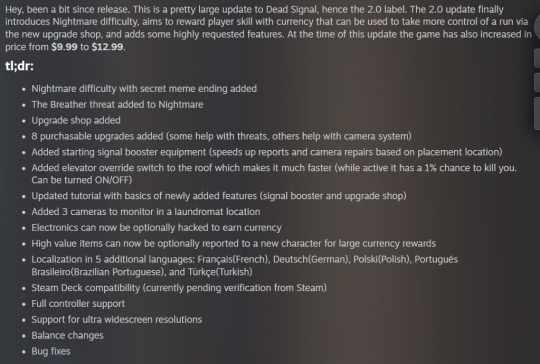
Image Transcript:
Hey, been a bit since release. This is a pretty large update to Dead Signal, hence the 2.0 label. The 2.0 update finally introduces Nightmare difficulty, aims to reward player skill with currency that can be used to take more control of a run via the new upgrade shop, and adds some highly requested features. At the time of this update the game has also increased in price from $9.99 to $12.99.
tl;dr:
Nightmare difficulty with secret meme ending added
The Breather threat added to Nightmare
Upgrade shop added
8 purchasable upgrades added (some help with threats, others help with camera system)
Added starting signal booster equipment (speeds up reports and camera repairs based on placement location)
Added elevator override switch to the roof which makes it much faster (while active it has a 1% chance to kill you. Can be turned ON/OFF)
Updated tutorial with basics of newly added features (signal booster and upgrade shop)
Added 3 cameras to monitor in a laundromat location
Electronics can now be optionally hacked to earn currency
High value items can now be optionally reported to a new character for large currency rewards
Localization in 5 additional languages: Français(French), Deutsch(German), Polski(Polish), Português Brasileiro(Brazilian Portuguese), and Türkçe(Turkish)
Steam Deck compatibility (currently pending verification from Steam)
Full controller support
Support for ultra widescreen resolutions
Balance changes
Bug fixes
rest of the notes below the cut, copied from the official steam post.
Nightmare difficulty
A greater challenge awaits those who've unlocked Nightmare by completing Normal difficulty. The Breather(threat) has been added to this mode. Difficulty has been increased across the board for everything. Completing Nightmare will reveal a secret meme ending, honoring those who triumph over the challenge. But be warned the mode is unfair, you'll need to master the ins and outs before you could ever dream of earning the God Gamer achievement for beating Nightmare.
Upgrades
Now players earn currency for completing tasks. Currency can be spent in the DarkDrop shop, which sells software (downloaded) and hardware (needs to be picked up on the roof). These upgrades vary in strength based on their cost and either help combat threats or upgrade the camera system. Some of the most common run ending situations can be mostly safeguarded against with select items from the DarkDrop shop. Purchased hardware will show a tool tip on pick up that shares the installation location. Additionally when you get close to the placement location with the item in your inventory a pulsing yellow hologram of the device will appear to make installation easy.
Elevator override
A switch outside the elevator on the roof has been installed. If flipped it will greatly increase the elevator's speed, however there's a 1% chance to snap the cable and cause death on each traveled to floor. Use it when needed, then turn it off to keep your future elevator trips death free. You'll see the largest benefit on long elevator rides. With the override switch on you can go to the lowest floor and back to your apartment in less time than it'd take to only go to the lowest floor with the standard elevator speed.
New cameras and new camera events
Three cameras from a laundromat have been added to the camera feed. There are new events to be reported that fall under the original six report categories.
Hacking electronic devices for currency rewards
A new character, Axecrypt enters your messages at the start and equips you with a hacking program that gives the option to either hack or report electronic devices. Hacking a device will offer a larger currency reward than reporting, but it can't be reported after. Likewise you can't report an electronic device, then hack it.
Reporting high value items for large currency rewards
A new character, Lotus has entered your messages and has an optional task for you to engage with. In the report tab you're now able to switch the recipient to either "The Shade" or "Lotus". Switching to Lotus and sending a valid high value report will result in a sizeable currency reward, but the event will no longer be reportable to The Shade for a quota point. Likewise if you report to The Shade first you'll no longer be able to report that same event to Lotus.
Signal booster starting equipment
There's a new device in your apartment that can greatly increase the speed of reports and camera malfunction repairs if placed in a hotspot. You can find it on a shelf next to the PC desk. Installing it in any of the apartment hallways is beneficial, though the better the spot, denoted by color(Green (strong), Yellow (moderate), Red (weak)), the more noticeable the difference. This device will change in status throughout the night, so moving it around will be ideal. Once you pick up the device from your apartment press [V] to toggle placement mode, then press [V] again while there is a hologram of the device to install it. You can pick the signal booster back up by pressing [F].
Localization
Translations have been made for the five most requested languages: Français(French), Deutsch(German), Polski(Polish), Português Brasileiro(Brazilian Portuguese), and Türkçe(Turkish). You can change the selected language on the main menu by opening the Options menu -> Game settings -> Language. In-game you can change the selected language by pressing [ESC] -> Game settings -> Language.
Controller Support
If you wanted to play with a controller now you're able to do so.
Steam Deck compatibility
As of this moment the review process is ongoing, but it's been tested and functions correctly on Steam Deck in this 2.0 build.
Ultrawide monitor support
Now larger screen resolutions (3440x1440 21:9) can play Dead Signal seamlessly. Those with super ultra widescreen resolutions (5120x1440 32:9) may not look the best, but are supported.
Balance Changes
Door lock state change (locked -> unlocked) can no longer be heard while near the PC. Players will need to purchase the upgrade to hear the beep and be notified of its change.
Increased specific event type spawns to correspond to new optional reporting alternatives (more high value and hack events)
Increased the time before certain threats trigger a player death
Increased the total camera event spawns across all hours and difficulties
Second half of your shift is now more demanding to compensate for the upgrades you can unlock during a run.
Increased volume of Delfalco's whistle
2 notes
·
View notes
Text
Catching Up on Tech News
1. Foursquare's Strategic Shift: Foursquare recently underwent significant restructuring, laying off 105 employees, which accounts for 25% of its workforce. The move aims to enhance operational efficiency and financial stability. This isn't the first time Foursquare has faced layoffs, having experienced similar cuts in 2020 and 2022. The company has transitioned from a consumer-focused app to a provider of enterprise data services, with its future financial outlook remaining uncertain.
2. Google Pay Enhancements: Google Pay is upping its game in the digital payment sphere by introducing new features geared towards enhancing the shopping experience. These include smarter shopping with rewards, flexible payment options through buy now, pay later (BNPL), and improved security verification methods using biometrics or PIN. These updates empower users to make informed decisions, maximize rewards, and enjoy a streamlined and secure payment process across various transactions.
3. Microsoft's AI Innovation: Microsoft's Cocreator feature within Paint is revolutionizing digital art creation by transforming quick sketches into realistic images in real-time. With options like Layers, Cocreator, and Image Creator, users can blend text and sketches seamlessly, adjusting creativity levels and styles. However, this feature currently requires specific hardware capabilities, limiting its accessibility to Copilot+ devices.
4. Apple Addresses Photo Bug: Apple swiftly addressed a bug in iOS 17.5 that caused deleted photos to reappear on iPhones and iPads. The fix was rolled out in iOS 17.5.1, which users can install via Settings > General > Software Update. While the root cause of the issue remains speculative, theories include indexing glitches, photo library corruption, or synchronization issues with iCloud Photos.
3 notes
·
View notes
Text
Applied AI - Integrating AI With a Roomba
AKA. What have I been doing for the past month and a half

Everyone loves Roombas. Cats. People. Cat-people. There have been a number of Roomba hacks posted online over the years, but an often overlooked point is how very easy it is to use Roombas for cheap applied robotics projects.
Continuing on from a project done for academic purposes, today's showcase is a work in progress for a real-world application of Speech-to-text, actionable, transformer based AI models. MARVINA (Multimodal Artificial Robotics Verification Intelligence Network Application) is being applied, in this case, to this Roomba, modified with a Raspberry Pi 3B, a 1080p camera, and a combined mic and speaker system.

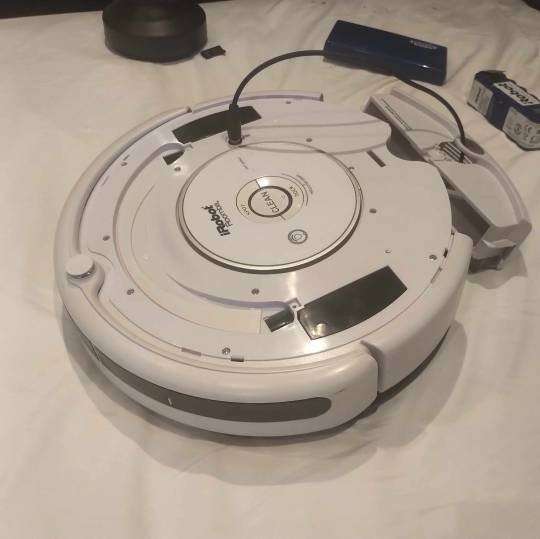
The hardware specifics have been a fun challenge over the past couple of months, especially relating to the construction of the 3D mounts for the camera and audio input/output system.
Roomba models are particularly well suited to tinkering - the serial connector allows the interface of external hardware - with iRobot (the provider company) having a full manual for commands that can be sent to the Roomba itself. It can even play entire songs! (Highly recommend)
Scope:
Current:
The aim of this project is to, initially, replicate the verbal command system which powers the current virtual environment based system.
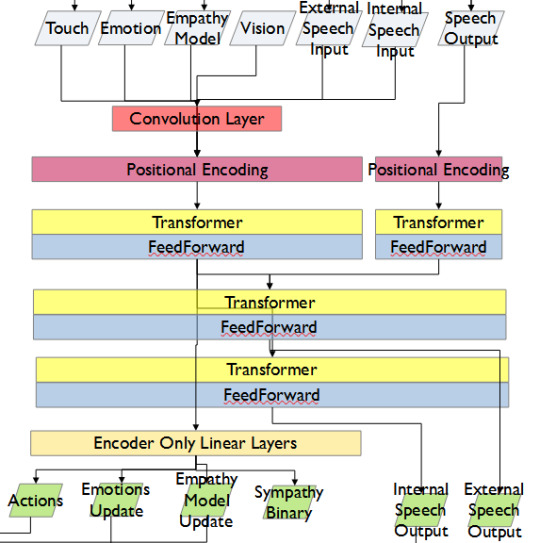
This has been achieved with the custom MARVINA AI system, which is interfaced with both the Pocket Sphinx Speech-To-Text (SpeechRecognition · PyPI) and Piper-TTS Text-To-Speech (GitHub - rhasspy/piper: A fast, local neural text to speech system) AI systems. This gives the AI the ability to do one of 8 commands, give verbal output, and use a limited-training version of the emotional-empathy system.
This has mostly been achieved. Now that I know it's functional I can now justify spending money on a better microphone/speaker system so I don't have to shout at the poor thing!
The latency time for the Raspberry PI 3B for each output is a very spritely 75ms! This allows for plenty of time between the current AI input "framerate" of 500ms.
Future - Software:
Subsequent testing will imbue the Roomba with a greater sense of abstracted "emotion" - the AI having a ground set of emotional state variables which decide how it, and the interacting person, are "feeling" at any given point in time.
This, ideally, is to give the AI system a sense of motivation. The AI is essentially being given separate drives for social connection, curiosity and other emotional states. The programming will be designed to optimise for those, while the emotional model will regulate this on a seperate, biologically based, system of under and over stimulation.
In other words, a motivational system that incentivises only up to a point.
The current system does have a system implemented, but this only has very limited testing data. One of the key parts of this project's success will be to generatively create a training data set which will allow for high-quality interactions.

The future of MARVINA-R will be relating to expanding the abstracted equivalent of "Theory-of-Mind". - In other words, having MARVINA-R "imagine" a future which could exist in order to consider it's choices, and what actions it wishes to take.
This system is based, in part, upon the Dyna-lang model created by Lin et al. 2023 at UC Berkley ([2308.01399] Learning to Model the World with Language (arxiv.org)) but with a key difference - MARVINA-R will be running with two neural networks - one based on short-term memory and the second based on long-term memory. Decisions will be made based on which is most appropriate, and on how similar the current input data is to the generated world-model of each model.
Once at rest, MARVINA-R will effectively "sleep", essentially keeping the most important memories, and consolidating them into the long-term network if they lead to better outcomes.
This will allow the system to be tailored beyond its current limitations - where it can be designed to be motivated by multiple emotional "pulls" for its attention.
This does, however, also increase the number of AI outputs required per action (by a magnitude of about 10 to 100) so this will need to be carefully considered in terms of the software and hardware requirements.
Results So Far:
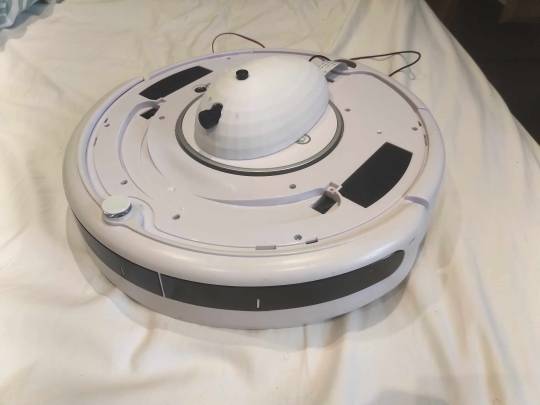
Here is the current prototyping setup for MARVINA-R. As of a couple of weeks ago, I was able to run the entire RaspberryPi and applied hardware setup and successfully interface with the robot with the components disconnected.
I'll upload a video of the final stage of initial testing in the near future - it's great fun!
The main issues really do come down to hardware limitations. The microphone is a cheap ~$6 thing from Amazon and requires you to shout at the poor robot to get it to do anything! The second limitation currently comes from outputting the text-to-speech, which does have a time lag from speaking to output of around 4 seconds. Not terrible, but also can be improved.
To my mind, the proof of concept has been created - this is possible. Now I can justify further time, and investment, for better parts and for more software engineering!
#robot#robotics#roomba#roomba hack#ai#artificial intelligence#machine learning#applied hardware#ai research#ai development#cybernetics#neural networks#neural network#raspberry pi#open source
8 notes
·
View notes
Text
Ultimate Guide to PCB Testing Methods: Ensuring Quality and Reliability in Your Circuits
In the electronics sector, Printed Circuit Boards (PCBs) are the life-lines of virtually all gadgets that are in use in the modern society. From humble home appliances to gigantic industrial equipment, PCBs are the skeletal framework of hardware organization and connection of circuit elements. It is vital to guarantee the quality and dependability of these fundamental parts – thus enters PCB testing methods. It is our hope that this extensive hand will help identify the most suitable test strategies for PCB testing, why these techniques matter, and how to maximize your circuits’ functionality.
Introduction

Firstly, an increase in the capability of different electronic devices leads to higher necessary requirements to the PCBs used in their production. Performing tests on the PCBs is an essential step in the manufacturing process done to confirm that a given board performs as a unit to the expected levels. This guide aims at explaining various techniques of PCB testing with a view of having a better understanding on how to achieve quality and reliability on the circuits.
Why PCB Testing is Crucial

PCB Testing When it comes to the potential defects on PCBs, there are shorts, opens, and some component placements. They can cause device failure, decline in performance level, and sometimes also pose safety issues. Through high-quality testing regimes, it becomes easier to address problems before they reach the customer, and thus manufacturers will have reliable and efficient products. Key reasons for PCB testing include:
Detecting Manufacturing Defects: Solder bridges, missing and placed in wrong position components, all can be detected in the initial stages easily.
Ensuring Functionality: Ensuring that the PCB does what is wanted and needed when it is in use, and under several conditions.
Quality Assurance: Ensuring that the business meets industry standards, and what clients require of them.
Cost Efficiency: Decreasing the likelihood of rework and recall by identifying possible defects before they get to the customer.
Types of PCB Testing Methods
These are the types of PCB Testing Methods:
Visual Inspection

Technique one as also referred to as the VI or visual inspection is the simplest and basic type of testing done on PCBs. The technique entails inspecting the board with naked eyes for some of the common faults including solder bridges, missing parts, and misalignment issues.
Automated Optical Inspection (AOI)

AOI employs cameras and software algorithms to check PCBs for defects and performs the inspections singly. This method of inspection is far more efficient than the manual inspection and simultaneously versatile enough to identify numerous problems.
X-ray Inspection

Some functions which include examination of features of BPCs that could not be easily inspected include solder joints under components through x-ray inspection. It is especially effective in inspecting defects in BGA (Ball Grid Array) and other various packages as well.
In-Circuit Testing (ICT)
ICT entails applying different voltage across the PCB to checks on the electrical characteristics of the needy part and connections. The use of this method is highly recommended for the identification of functional problems and verification of the circuit’s goodness.
Functional Testing (FCT)
Functional testing evaluates the effectiveness of the PCB pointing to the fact that it can be tested when placed in use. This method enables the certification of that the PCB works as expected under actual environment.
Flying Probe Testing
In flying probe testing, the probes are moved around to test the electrical properties of the created PCB. Lower to medium volume production runs can be made easily by using this technique; hence it is advantageous in this regard.
Boundary Scan Testing
Boundary scan testing also called as JTAG testing extends test circuitry into all the components for testing the connections between them. Although, this method is very efficient for identifying connection problems and faults.
Burn-In Testing
Burn-in testing puts the PCB in a state of operational stress for a long time to capture early-life failures. This aspect makes the method reliable for the long term since it is likely to identify problems that may occur when the equipment is in use for a long time.
Detailed Analysis of Each Testing Method works
These are the detailed analysis of each testing method works:
Visual Inspection
Pros:
Simple and low-cost
Determined to be a system for the reporting of noticeable defects as soon as they are observed.
Cons:
Time-consuming for complex boards
Limited to visible defects
Automated Optical Inspection (AOI)
Pros:
Fast and accurate
Is capable of detecting various kinds of defects.
Non-destructive
Cons:
High initial setup cost
May need to have better settings optimized for specific boards.
X-ray Inspection
Pros:
Examines hidden features
Ideal for complex packages
Cons:
Expensive equipment
Requires skilled operators
In-Circuit Testing (ICT)
Pros:
Thorough electrical testing
High fault coverage
Cons:
Requires custom fixtures
Not for all the boards or servers that you wish to build.
Functional Testing (FCT)
Pros:
Ensures real-world performance
Detects system-level issues
Cons:
Time-consuming
The mathematical test object can involve complex arrangements of test configurations.
Flying Probe Testing
Pros:
Flexible and adaptable
Cost-effective for small batches
Cons:
Slower than ICT for big volumes
Applicable only when the board is specially designed
Boundary Scan Testing
Pros:
Interconnections have high fault coverage.
Said; No need to have physical access to the test points
Cons:
Requires boundary scan-enabled components
Complex setup
Burn-In Testing
Pros:
Identifies early-life failures
Ensures long-term reliability
Cons:
Time-consuming and costly
Perhaps stressful to the board
Choosing the Right Testing Method
The choice of the appropriate method of PCB testing can be influenced by several factors such as the level of complexity of the PCB and the numbers of boards to be tested as well as the actual costs of the testing process and other features. Consider the following when choosing a testing method:
Board Complexity: Great board densities or component placement can be a determinant as to whether one needs AOI or X-ray inspection.
Production Volume: Applications that are characterized by high volumes can be easily facilitated by ICT while the low to medium volume applications may require flying probe testing.
Budget: Both manual inspection and AOI are favorable for various production volumes, while X-ray and ICT are more expensive at the beginning.
Specific Requirements: There are two types of the test, namely Functional Test and Burn-In Test that should be made so as to attain the long term reliability in applications that are critical.
Best Practices for PCB Testing
Using the best techniques in testing PCBs increases the quality and reliability of the circuits that you are working on. Here are some key practices to follow:
Early Testing: It is recommended to carry out the tests when the product is still in its design and manufacturing phase so that problems can be noted earlier before they reach a very catastrophic level.
Automate Where Possible: Use method such as automation to reduce the time and improve on the quality of the testing.
Regular Calibration: It is necessary to check if all the testing equipment used for calibration are accurate.
Comprehensive Coverage: This way, you will be able to ensure that there are no defects that are not tested as the best testing approach combines all types of testing methods.
Document Everything: Ensure that you keep records of the tests performed, the results obtained, as well as any measures taken to correct the breaches.
Common Challenges and How to Overcome Them
These are the common challenges and how to overcome them:
False Positives/Negatives
Automated testing methods maybe good some times, they give you the results that are either positive or negative and this will lead to unnecessary rework or more alarming leaving critical defects unfound. In order to avoid this, make sure that testing algorithms and testing equipment are updated and fine-tuned from time to time.
Component Access
Some of the testing techniques involve handling parts of the circuit and with high density board this can be very difficult. Some of the ways in which testbench implementation can be avoided are as follows Boundary scan testing and X-ray inspection.
High Costs
Some form of testing such as X-ray and ICT testing is often very costly. The effectiveness must come with reasonable prices; try to combine some of the mentioned approaches to cover all the aspects without spending too much money.
Future Trends in PCB Testing
About the future, it can be stated that its trends will be in fact linked to the tendencies in technologies and expectations towards ever higher quality and quantity of tested PCBs. Key trends to watch include:
AI and Machine Learning: Using of intelligence algorithms and machine learning in testing algorithms to enhance the efficiency and the minimization of false negative or false positives.
IoT and Smart Manufacturing: Higher testing flexibility and opportunities for the continuous test process supervision.
Advanced Imaging Techniques: The need for better techniques that would enhance the detection of defects within a printed circuit.
Environmental Stress Testing: More focus in the testing of PCBs under different environmental pressures in order to improve on its longevity.
Conclusion
Quality and reliability of packaged circuits have to be maintained to contribute positively in any electronic equipment. This paper seeks to explain the common testing techniques for PCB so that PCB manufacturers are able to test and see if they are free from defects and if they are functional. This ultimate guide will give you a full insight on the available options in PCB testing that will enable you make the best decision that will give you perfect circuits.
The aim is to help you understand how to attain the best quality of PCBs, what methods are worth following, and what trends drive future improvements, thus contributing to the quality of the final electronic products and, consequently, consumer satisfaction.
#PCBTesting#Electronics#CircuitBoard#QualityControl#Engineering#Technology#Manufacturing#IndustrialDesign#Tech#Innovation
2 notes
·
View notes